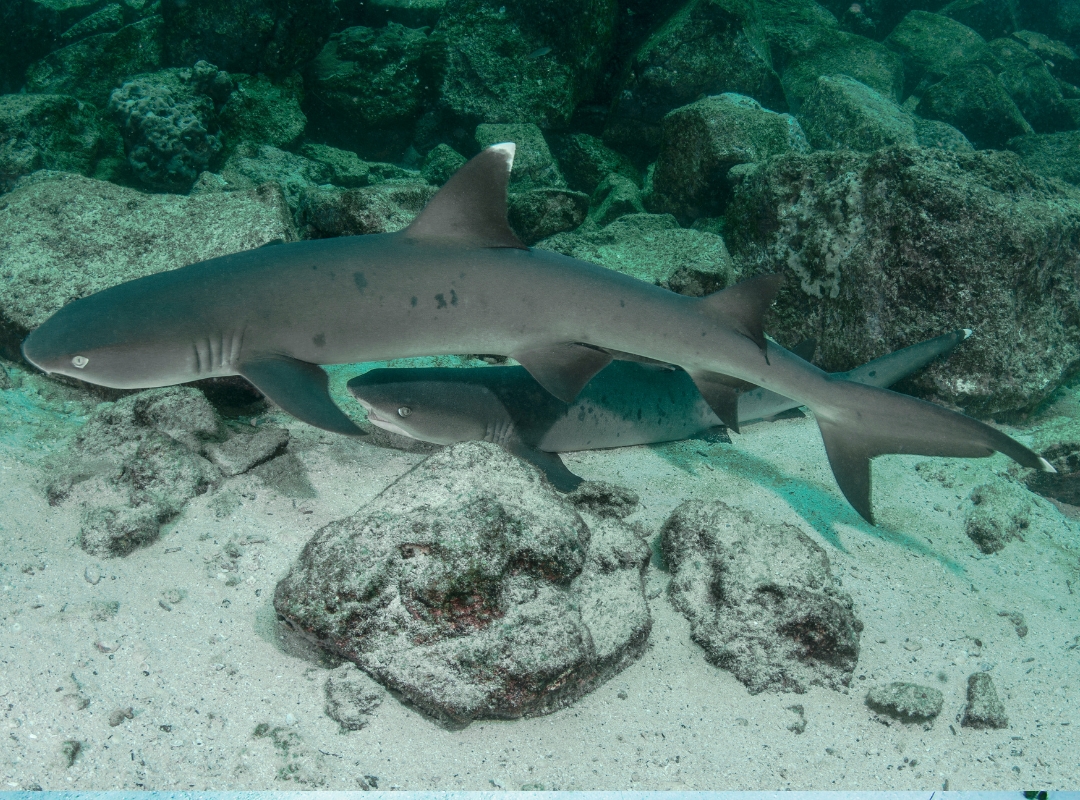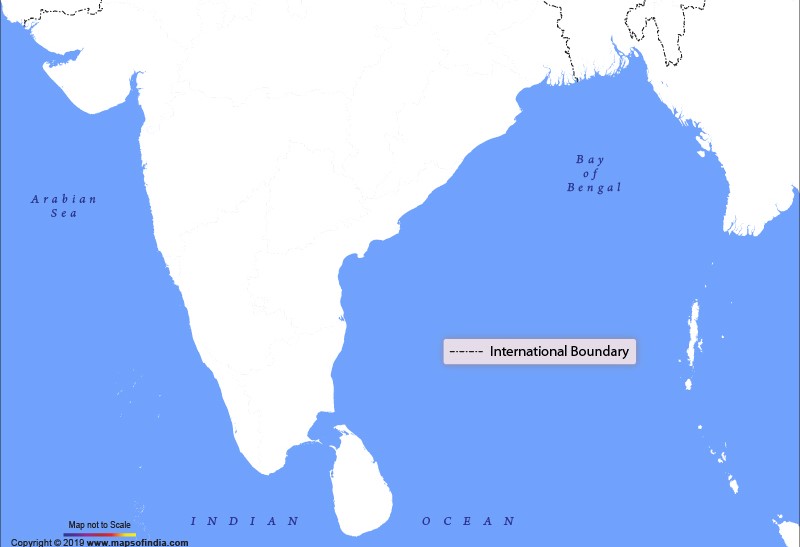Species Name
Whitetip Reef Shark
Scientific Name
Triaenodon obesus
Family Name
Carcharhinidae
IUCN Status
Vulnerable
A small, slender shark with an extremely short, broad snout, oval eyes, and conspicuous white tips on the 1st dorsal (sometimes 2nd) and upper caudal fins; 2nd dorsal almost as large as 1st; no interdorsal ridge. Spiracles usually present, teeth 47-50/ 44-46, in at least 2 functional rows. Grey above, lighter below and sometimes with dark spots on sides. First dorsal-fin lobe and dorsal caudal-fin lobe with conspicuous white tips, second dorsal-fin lobe and ventral caudal-fin lobe often white-tipped.
Biology
Length: It reaches a maximum size of 200 cm total length (TL) but adults are very rare over 160 cm. Size-at-maturity is about 105 cm TL. Size-at-birth of 52–60 cm TL.
Gestation Period: ~5 months
Litter Size: 1-5
Life Expectancy: Attain sexual maturity at eight to nine years and live to about 16 years. Generation length is estimated to be 12.3 years.
Diet: Feeds on benthic animals such as fishes, octopi, spiny lobsters and crabs.
Habitat and distribution
Habitat: Sluggish inhabitant of lagoons and seaward reefs where it is often found resting in caves or under coral ledges during the day, or usually on a sand patch, or in a channel. More active at night or during slack tide in areas of strong currents.
Distribution: The Whitetip Reef Shark is widespread in the tropical Indo-Pacific Ocean from western Africa to the Eastern Pacific.
Known landing centres: Junglighat, Burmanallah, Wandoor, Dignabad, and Cochin Fisheries Harbour
Depth: 0-330 m
Commercial Value
The meat of this species is sold fresh, frozen, salted and dried for human consumption at local markets throughout it range. The fins are retained, and Fields et al. (2018) reported that this species made up 0.04% of fin trimmings sold in Hong Kong. Skins, teeth, and liver are also retained at times.
Threats
The Whitetip Reef Shark is caught throughout its range in industrial and small-scale longline, gillnet, trawl and handline fisheries that occur in the waters around coral reefs. Most is taken as incidental catch in general reef fisheries targeting teleost fishes. The species is often retained for its meat, fins, and liver. The species is also taken in small amounts by recreational fishers in some countries. In many parts of east Africa, and south and east Asian, there are large amounts of fishing effort targeted at carcharhinid sharks in continental shelf waters, and it continues to increase. For example, in the waters of Indonesia effort by small-scale fisheries has tripled when taking population into account; and in Myanmar the International Labour Organisation (2015) estimated the number of vessels participating in the small scale inshore fishery to be about 26,000 in 2013, and the number of locally operated larger offshore vessels numbered 2,846 in 2013, having increased nearly 30% since 2009. Only in locations where fisheries are strictly regulated (e.g. Australia), where human population densities are low, or where dive-based tourism supports protection are there low levels of threat that enable this species to remain common.
The reliance of this species on coral reefs makes it susceptible to declines in habitat quality. Global climate change has already resulted in large-scale coral bleaching events with increasing frequency causing worldwide reef degradation since 1997. Almost all warm-water coral reefs are projected to suffer significant losses of area and local extinctions, even if global warming is limited to 1.5ºC. Destructive fishing practices in some nations (e.g. dynamite fishing) and declining water quality have also led to the decline in coral reef habitat.
References
Compagno, L.J.V. (1984)
Sharks of the World. An annotated and illustrated catalogue of shark species to date. Part II (Carcharhiniformes). FAO Fisheries Synopsis, FAO, Rome.
Dwyer, R.G., Krueck, N.C., Udyawer, V., Heupel, M.R., Chapman, D., Pratt, H.L., Garla, R., Simpfendorfer, C.A. (2020)
Individual and population benefits of marine reserves for reef sharks. Current Biology 30: 480–489.
Espinoza, M., Cappo, M., Heupel, M.R., Tobin, A.J. and Simpfendorfer, C.A. (2014)
Quantifying shark distribution patterns and species-habitat associations: implications of Marine Park Zoning. PLOS ONE 9(9): e106885.
Fields, A.T., Fischer, G.A., Shea, S.K., Zhang, H., Abercrombie, D.L., Feldheim, K.A., Babcock, E.A. and Chapman, D.D. (2018)
Species composition of the international shark fin trade assessed through a retail‐market survey in Hong Kong. Conservation Biology 32(2): 376–389.
Graham, N.A., Spalding, M.D. and Sheppard, C.R. (2010)
Reef shark declines in remote atolls highlight the need for multi-faceted conservation action. Aquatic Conservation: Marine and Freshwater Ecosystems 20: 543–548.
Heupel, M.R., Williams, A., Welch, D., Ballagh, A., Mapstone, B., Carlos, G., Davies, C. and Simpfendorfer, C.A. (2009)
Effects of fishing on tropical reef associated shark populations on the Great Barrier Reef. Fisheries Research 95: 350-361.
International Labour Organization (2015)
Value chain analysis and competitiveness strategy: marine capture fisheries: Myeik and Yangon, Myanmar. International Labour Organization, ILO Liaison Officer for Myanmar. Yangon.
IUCN (2020)
The IUCN Red List of Threatened Species. Version 2020-3. Available at: www.iucnredlist.org. (Accessed: 10 December 2020).
Last, P.R. and Stevens, J.D. (2009)
Sharks and Rays of Australia, 2nd edition. CSIRO, Melbourne, Australia.
MacNeil, M.A., Chapman, D.D., Heupel, M., Simpfendorfer, C.A., Heithaus, M., Meekan, M., Harvey, E., Goetze, J., Kiszka, J., Bond, M.E., Currey-Randall, L.M., Speed, C.W., Sherman, C.S., Rees, M.J., Udyawer, V., Flowers, K.I., Clementi, G., Valentin-Albanese, J., Gorham, T., Adam, M.S., Ali, K., Pina-Amargós, F., Angulo-Valdés, J.A., Asher, J., Barcia, L.G., Beaufort, O., Benjamin, C., Bernard, A.T.F., Berumen, M.L., Bierwagen, S., Bonnema, E., Bown, R.M.K., Bradley, D., Brooks, E., Brown, J.J., Buddo, D., Burke, P., Cáceres, C., Cardeñosa, D., Carrier, J.C., Caselle, J.E., Charloo, V., Claverie, T., Clua, E., Cochran, J.E.M., Cook, N., Cramp, J., D’Alberto, B., de Graaf, M., Dornhege, M., Estep, A., Fanovich, L., Farabough, N.F., Fernando, D., Flam, A.L., Floros, C., Fourqurean, V., Garla, R., Gastrich, K., George, L., Graham, R., Guttridge, T., Hardenstine, R.S., Heck, S., Henderson, A.C., Hertler, H., Hueter, R., Johnson, M., Jupiter, S., Kasana, D., Kessel, S.T., Kiilu, B., Kirata, T., Kuguru, B., Kyne, F., Langlois, T., Lédée, E.J.I., Lindfield, S., Luna-Acosta, A., Maggs, J., Manjaji-Matsumoto, B.M., Marshall, A., Matich, P., McCombs, E., McLean, D., Meggs, L., Moore, S., Mukherji, S., Murray, R., Kaimuddin, M., Newman, S.J., Nogués, J., Obota, C., O’Shea, O., Osuka, K., Papastamatiou, Y.P., Perera, N., Peterson, B., Ponzo, A., Prasetyo, A., Quamar, L.M.S., Quinlan, J., Ruiz-Abierno, A., Sala, E., Samoilys, M., Schärer-Umpierre, M., Schlaff, A., Simpson, N., Smith, A.N.H., Sparks, L., Tanna, A., Torres, R., Travers, M.J., van Zinnicq Bergmann, M., Vigliola, L., Ward, J., Watts, A.M., Wen, C., Whitman, E., Wirsing, A.J., Wothke, A., Zarza-Gonzâlez, E. and Cinner, J.E. (2020)
Global status and conservation potential of reef sharks. Nature 583: 801–806.
MacNeil, M.A., Mellin, C, Matthews, S., Wollf, N.H., McClanahan, T.R., Devlin, M., Drovandi, C., Mengersen, K, Graham, N.A.J. (2019) Water quality mediates resilience on the Great Barrier Reef. Nature Ecology and Evolution 3: 620–627.
Nadon, M.O., Baum, J.K., Williams, I.D., Mcpherson, J.M., Zgliczynski, B.J., Richards, B.L., Schroeder, R.E. and Brainard, R.E. (2012)
Re-creating missing population baselines for Pacific reef sharks. Conservation Biology 26(3): 493-503.
Ramenzoni, V.C. (2017)
Reconstructing the history and effects of mechanization in a small-scale fishery of Flores, Eastern Indonesia (1917–2014). Frontiers in Marine Science 4(65): doi: 10.3389/fmars.2017.00065.
Randall, J.E. (1977)
Contribution to the biology of the whitetip reef shark (Triaenodon obesus). California Wild (formerly known as Pacific Science) 31(2): 143–164.
Robbins, W.D., Hisano, M., Connolly, S.R. and Choat, J.H. (2006) Ongoing collapse of coral-reef shark populations. Current Biology 16: 2314–2319.
Smith, S.E., Au, D.W. and Show, C. (1998) Intrinsic rebound potentials of 26 species of Pacific sharks. Marine and Freshwater Research 49(7): 663–678.
Whitney, N.M., Robbins, W.D., Schultz, J.K., Bowen, B.W., Holland, K.N. (2012)
Oceanic dispersal in a sedentary reef shark (Triaenodon obesus): genetic evidence for extensive connectivity without a pelagic larval stage. Journal of Biogeography 39: 1144–1156.


Related Species
- Tiger Shark
- Silky Shark
- Blacktip Reef Shark
- Common Blacktip Shark
- Spot-tail Shark
- Milk Shark
- Spadenose Shark
- Bignose Shark
- Blackspot Shark
- Blue Shark
- Broadfin Shark
- Bull Shark
- Dusky Shark
- Ganges Shark
- Graceful Shark
- Grey Reef Shark
- Grey Sharpnose Shark
- Hardnose Shark
- Sliteye Shark
- Silvertip Shark
- Sharptooth Lemon Shark
- Sandbar Shark
- Pondicherry Shark
- Pigeye Shark
- Oceanic Whitetip Shark
- Irrawaddy River Shark
- Speartooth Shark
- Spinner Shark
- Whitecheek Shark

